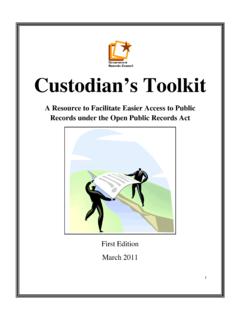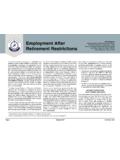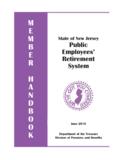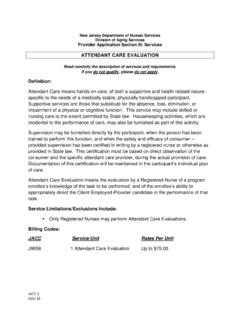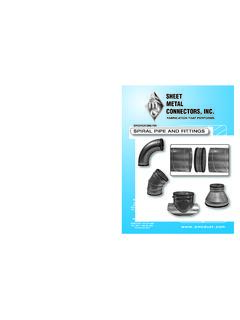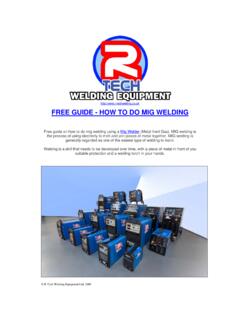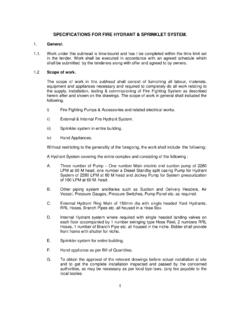Transcription of Machinist Dies After Being Pulled Into Engine Lathe
1 Fatal Occupational Injuries Surveillance Project FOIS 16-NJ-05 June 13, 2017 Machinist Dies After Being Pulled Into Engine Lathe A 57-year-old male Machinist died After Being Pulled into the Engine Lathe he was operating. The incident occurred in a small commercial metal machining facility in northern New Jersey. On the day of the incident, the victim was filing a 36-inch long, two-inch diameter, high-nickel, stainless -steel alloy rod on an Engine Lathe . With the chuck rotating, the victim was using a metal file to smooth out portions of the bar when the sleeve of his sweater became caught in the jaws of the chuck. He was Pulled up into the Lathe and sustained traumatic blunt impact injuries to his left arm and head.
2 The victim died instantly, and was pronounced dead at the scene. Contributing Factors: Victim wearing a long-sleeved, loose-fitting sweater Working in close proximity to rotating chuck NJ FOIS investigators recommend that these safety guidelines be followed to prevent similar incidents: A safety and health plan based on a job hazard analysis should be developed by the employer and followed where workers are assigned tasks. While operating an Engine Lathe , long sleeves should never be worn. An emergency stop system should be in place that the operator can access at any time. A Lathe spindle (with chuck) should be adequately guarded to prevent operator contact. Refresher training should be provided to all workers on a regular basis. OIS Public Health Services Branch Division of Epidemiology, Environmental and Occupational Health Occupational Health Surveillance Unit (609) 826-4984 2 INTRODUCTION In winter 2016, NJ FOIS staff was notified of the death of a 57-year-old male Machinist who was killed After Being Pulled into an Engine Lathe .
3 The incident occurred in a small, nonunion machine shop in northern NJ. The victim had worked for the company for approximately eight years, but had experience using a Lathe for almost 20 years at another company. The current employer verbally noted health and safety training occurred, but no documented records of machine operator training were provided. An NJ FOIS investigator contacted the OSHA Area Office and conducted a concurrent investigation. Additional information was obtained from the medical examiner s report, death certificate, and police report. INVESTIGATION The incident site was the machine floor of a small metal machining company in northern NJ. The employer owned the facility, which was contracted to machine various pieces of stainless steel and other metals to specification for clients.
4 The majority of the outputs of the shop were finished shafts for commercial pumps. The piece the victim was working on was a high-nickel content, stainless steel, 2 diameter rod (36 long), intended for a high-temperature smelter. The increased nickel content of the steel provided the needed temperature resistance for the client. On the day of the incident, the victim was using an Engine Lathe to cut and finish the rod (Figures 1-2), a task he had performed many times in the past. He was using a 15 metal file to smooth down areas of the rod (Figure 3). According to the manager of the facility, in order to file correctly, the rod had to be rotating (that is, the chuck was spinning). 3 FIGURE 1: Front view of Engine Lathe the victim was operating. Yellow circle indicates the point where the incident occurred; a close-up view of this can be seen in Figure 2.
5 FIGURE 2. Close-up view (with the guard raised) of spindle with chuck. The jaws hold the part to be machined (in this case, a rod) to the chuck. headstock main motor On/Off switches apron bed tailstock footbrake rod jaws spindle (with chuck) 4 Figure 3. Fifteen-inch, metal file used by the victim. Although there were no witnesses, based on where the victim was in the machining process and the condition he was found in, it was concluded that the victim, who was right handed, was filing perpendicular to the bar with his right hand forward. He was wearing a long-sleeve, loose-fitting sweater. As he was filing, he misjudged his proximity to the rotating spindle, his sweater caught in the jaws, and he was Pulled up and into the Lathe . The two coworkers in the shop, who were operating computer numerical controlled (CNC) lathes toward the front of the shop at the time, heard a popping, thumping noise that they knew did not originate from normal Lathe work.
6 One of the coworkers called to the victim but heard no response. He ran over and found the victim lying on the floor bleeding from the head, with both his sweater and undershirt Pulled from his body and entrapped in the Lathe (Figure 4). He suffered a severely fractured left arm and massive head injuries. He died instantly from his injuries, and was pronounced dead at the scene by the Medical Examiner. 5 Figure 4. Victim s sweater and undershirt entrapped by the Lathe . 6 RECOMMENDATIONS/DISCUSSIONS Recommendation #1: A safety and health plan based on a job hazard analysis should be developed by the employer and followed where workers are assigned tasks. Discussion: Employers should conduct a job hazard analysis, with the participation of employees, of all work areas and job tasks.
7 A job hazard analysis should begin by reviewing the work activities for which the employee is responsible, and the equipment that is needed. Each task is further examined for mechanical, electrical, chemical, or any other hazard the worker may encounter. A source of information on conducting a job hazard analysis can be obtained from the US Department of Recommendation #2: While operating an Engine Lathe , long sleeves should never be worn. Discussion: When working with any machine, OSHA describes that safe work practice procedures should prohibit employees from wearing loose-fitting clothing, jewelry, or gloves that can be entangled in moving machine In this case, the victim was wearing a long-sleeve, loose-fitting sweater. NJ FOIS recommends employers provide all machine operators appropriate uniform clothing, and adopt strict machine shop rules that prohibit any long sleeves, loose-fitting clothing, jewelry, unsecured long hair, or gloves that could become entangled in machinery.
8 In addition, all lathes should have a posted warning label indicating to never operate the machine while wearing long sleeves, jewelry, or anything else that can become entrapped in moving parts. Recommendation #3: An emergency stop system should be in place that the operator can access at any time. Discussion: During the normal operation of the Engine Lathe used in this incident, a lever and footbrake are used to start and stop the spindle (Figure 5). With the machine s main drive motor on (green button, Figure 5), the operator uses the spindle rotation lever to begin the rotation of the object to be worked upon. When the operator needs to stop the rotation, the footbrake is pressed. However, during this incident, as the victim was Being Pulled upward into the Lathe , he could no longer reach the footbrake.
9 There is a stop button located next to the main drive motor, but this is out of reach for any operator working the machine (Figure 5). NJ FOIS recommends that the manufacturer develop a stop mechanism or stop system that can be accessed anytime and from anywhere the operator is working. 7 FIGURE 5. View of Stop Button and Footbrake. stop button footbrake spindle rotation lever Main drive on button 8 Recommendation #4: A Lathe spindle (with chuck) should be adequately guarded to prevent operator contact. Discussion: According to 29 CFR (a)(1), the point of operation of equipment such as lathes must be guarded to protect the Moreover, ANSI specifies that manual lathes shall be safeguarded with a chuck This particular Engine Lathe had a metal guard that covered the chuck (Figure 6), which the operator could swing up or down.
10 At the time of the incident, while the operator was filing the stainless -steel alloy rod, the guard was in the up position, leaving the spindle exposed. NJ FOIS recommends that the guard always be in the down position while the spindle is rotating, however, if this would inhibit the job task, then a different type of guard should be used that would protect the operator from contacting the chuck. FIGURE 6. Engine Lathe with guard in down position. chuck guard 9 Recommendation #5: Refresher training should be provided to all workers on a regular basis. Discussion: This incident occurred even though the operator was highly skilled and experienced with an Engine Lathe . NJ FOIS recommends that Lathe operators undergo refresher training to be reminded of safe work practices. This should include the importance of not wearing loose fitting clothing, or jewelry while operating a Lathe , and should review emergency shut down procedures.
